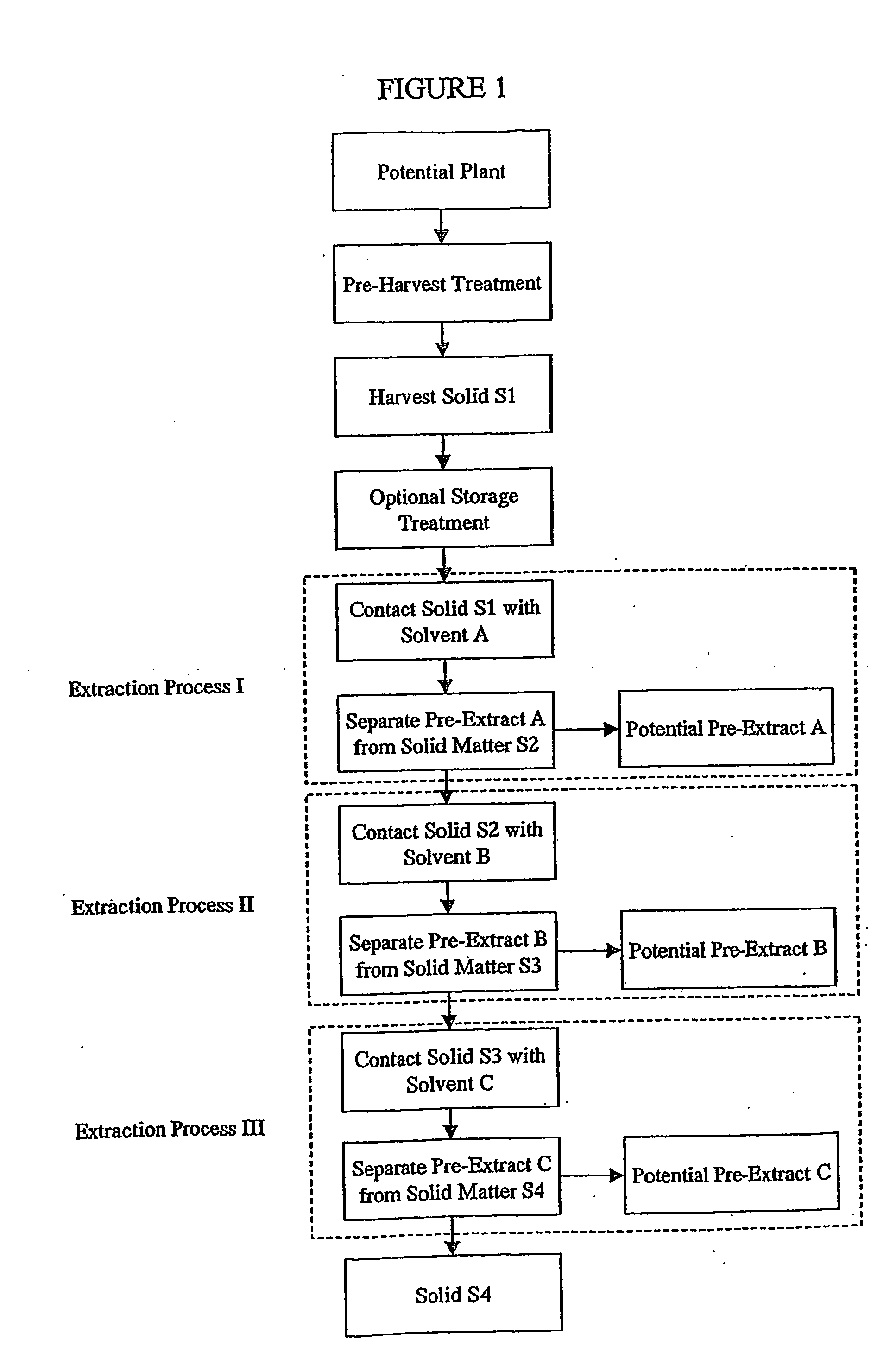Plant extracts for treatment of angiogenesis and metastasis
a plant extract and angiogenesis technology, applied in the field of extracellular proteases inhibitors, to achieve the effect of slowing down, inhibiting or preventing angiogenesis, slowing down, inhibiting or preventing metastasis
- Summary
- Abstract
- Description
- Claims
- Application Information
AI Technical Summary
Benefits of technology
Problems solved by technology
Method used
Image
Examples
example i
Preparation of Stressed and Non-stressed Plant Extracts
[0156] Pre-Harvest Treatment: Aerial parts of a living plant are sprayed with an aqueous solution of gamma linolenic acid (6,9,12-Octadecatrienoic acid, Sigma L-2378) (stress G) or arachidonic acid (5,8,11,14-Eicosatetraenoic acid, Sigma A-3925) (stress A) (400 μM in water with 0.125% (v / v) Triton X-100) to completely cover the leaves. Twenty to twenty-four hours after the stress, plants are harvested.
Harvest Solid S1 and Optional Storage Treatment
[0157] Twenty to twenty-four hours after the stress, more than 4 grams of leaves, stems, fruit, flowers, seeds or other plant parts are harvested and frozen immediately in dry ice, then transferred as soon as possible to a −20° C. freezer until use. Plant materials may be stored at −20° C. for a long period of time, more than a year, without losing inhibitory activity. Temperature is monitored to ensure a constant condition.
[0158] Stressed and non-stressed plant specimens are coll...
example ii
In Vitro Enzyme Inhibition Assays
[0166] The inhibitory activity of sample compositions towards human MMP-1, human MMP-2, human MMP-3, human MMP-9, human cathepsin-B, human cathepsin-D, human cathepsin-G, human cathepsin-L, human cathepsin-K, human leukocyte elastase (HLE), bacteria clostripain and bacteria subtilisin can be determined using either fluorogenic substrates or the FASC assay.
Measurement of Human MMP-1, -2, -3 and -9 Activity with Fluorogenic Peptidic Substrates
[0167] MMP-1, -2, -9 are purified from natural sources human immortalized cell lines: 8505C (Deutsche Sammlung von Mikroorganismen und Zellkulturen GmbH) for MMP-1, HT-1080 (ATCC, Manassas, Va.) for MMP-2 and TBP-1 (ATCC, Manassas, Va.) for MMP-9) as described in literature and based on protocols found in I. M. Clark: Matrix metalloproteinases protocols>>, Humana Press (2001). Recombinant human MMP-3 is overexpressed in E. coli and purified according to Windsor L J, Steele D L (2001), Methods Mol Biol 151:191-...
example iii
Exemplary Purification of Inhibitory Activity Found in an Extract
[0177] Extracts were separated by HPLC on an Agilent 1100 system (San Fernando, Calif.). Briefly, 100 μL of a crude extract prepared as described in Example I was applied on a C18 reverse-phase column (Purospher RP-18 5 μm, 4.0×125 mm (BP), Agilent, San Fernando, Calif.). Elution of compounds was achieved with a linear gradient of 10-85% acetonitrile. Fractions were collected, evaporated, resuspended in aqueous buffer and then reanalysed for their inhibition activity on specific enzymes as already described. Fractions of interest (demonstrating a biological activity) where then reisolated at a larger scale for further analysis and characterisation.
PUM
| Property | Measurement | Unit |
|---|---|---|
| Mass | aaaaa | aaaaa |
| Molar density | aaaaa | aaaaa |
| Fraction | aaaaa | aaaaa |
Abstract
Description
Claims
Application Information
 Login to View More
Login to View More - R&D
- Intellectual Property
- Life Sciences
- Materials
- Tech Scout
- Unparalleled Data Quality
- Higher Quality Content
- 60% Fewer Hallucinations
Browse by: Latest US Patents, China's latest patents, Technical Efficacy Thesaurus, Application Domain, Technology Topic, Popular Technical Reports.
© 2025 PatSnap. All rights reserved.Legal|Privacy policy|Modern Slavery Act Transparency Statement|Sitemap|About US| Contact US: help@patsnap.com



